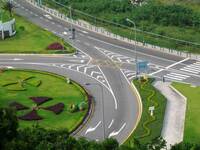- England
- Scotland
- France
- Holland
- Germany
- Italy
- Spain
- Portugal
- USA
- China
- Japan
- India
- Iran
- Advice
- Gardens
- England
- Scotland
- France
- Holland
- Germany
- Italy
- Spain
- Portugal
- USA
- China
- Japan
- India
- Iran
- Advice
- Garden Tours
Book: Landscape Planning and Environmental Impact Design: from EIA to EID
Chapter: Chapter 11 Urbanisation and growth management
An American transport consultant wrote that 'the planning of new towns must start with the pedestrian, from the point of view of both transportation and livability. All other transportation elements must conform to that framework' (Bailey 1973: 79). Otherwise the town will be dominated by vehicles. The predominance of road transport was the greatest weakness of the British new towns. The problem is exemplified by Runcorn. It has a dramatic site and is based on a sound landscape concept, but: Without a good map and an alert eye for road signs, frustration and disorientation are inevitable. Expressways are generally placed in wide parkland strips, fenced off from pedestrians, and crossed only by walkwayï¾bridges at limited places. The busways are also fenced, as they pass through the middle of the residential neighbourhoods, which are thus effectively cut in two. Roads and busways therefore become barriers rather than links. The excessive emphasis on segregating them, is the result of what now appears to be an almost neurotic reaction to the danger of the motor vehicle, and tends to dominate the town (Opher & Bird 1980: 4). Lavish expenditure on vehicular circulation has been wasteful of resources and, if the roads and busways were not underused, fastï¾moving traffic would be a serious cause of noise and air pollution. The footpaths in Cumbernauld are dwarfed by the road system. Walking distances from inner housing areas to the ridgeï¾top shopping centre are short and unpleasant, except in midsummer. Pedestrians must walk uphill and cross narrow bridges over wide, underused, roads. From outer housing areas the journey is arduous. One suspects that only unemployment and low car ownership keep the footpaths in use (Opher & Bird 1981: 2-4). At Washington New Town the main road looks like an airport runway and is designed to carry more traffic than many sections of the A1 London to Edinburgh trunk road. Even Thamesmead, which is inside Greater London, has been overï¾provided with roads to a surprising degree. The highways to the town centre could be mistaken for a major regional artery. Future new towns should be designed to facilitate internal journeys by foot or bicycle.
